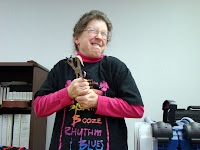 If no other calls come from U.S.F.&W. or ERA Aviation today, BE 08-82 will be the last eagle we'll take in for 2008. He came from Cordova with a fracture at his left wrist that had already healed, but improperly. It's non-repairable, so he's a non-releasable bird. We'll find a home for him in 2009. He's already at the Flight Center getting plenty of exercise.
If no other calls come from U.S.F.&W. or ERA Aviation today, BE 08-82 will be the last eagle we'll take in for 2008. He came from Cordova with a fracture at his left wrist that had already healed, but improperly. It's non-repairable, so he's a non-releasable bird. We'll find a home for him in 2009. He's already at the Flight Center getting plenty of exercise.He'll make the 82nd eagle that Bird TLC has taken into its care in 2008. We have also taken in over 450 other types of wildbirds. I'll get you an exact count after the 1st.
As you can imagine this doesn't come by inexpensively. Today's economy has started to take it's effect on all non-profits, not just us. No matter what the economy does, we'll still be here doing what we do with what we have to do it with.
Those of you that read this blog know that I don't hound you for donations but just a couple times a year. Well, this is one of them. For those of you that need a tax break, we are a 501(c)3. For those of you from outside the US, sorry. But we still need your help.
500 plus birds takes its toll on the facility, equipment and supplies. Everything we have is well taken care of, but it still wears out. Updated equipment to us is the hand me down equipment that someone replaced to update theirs. We are grateful for it, but it still has high mileage by the time we get it.
So, if you have it in your heart to donate to a non-profit, I hope you pick TLC. There are thousands that need your help. If you don't pick TLC, please pick one. Being a salesman in my real life I have to add a perk for you. If you donate over $100 on PayPal by January 5, 2009 I will personally send a thank you letter. In that letter will include 2 Bird TLC items that aren't readily available to everyone. You have to donate to get them and you won't know what they are until you do.
Here's hoping everyone has a safe and Happy New Year!











